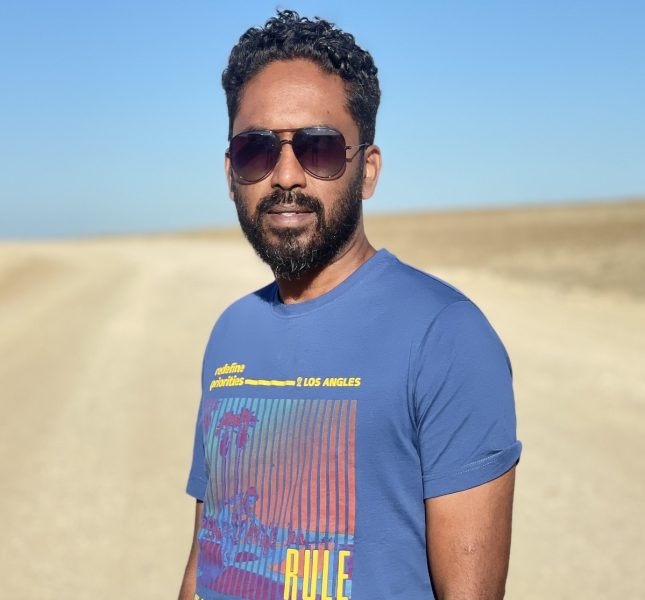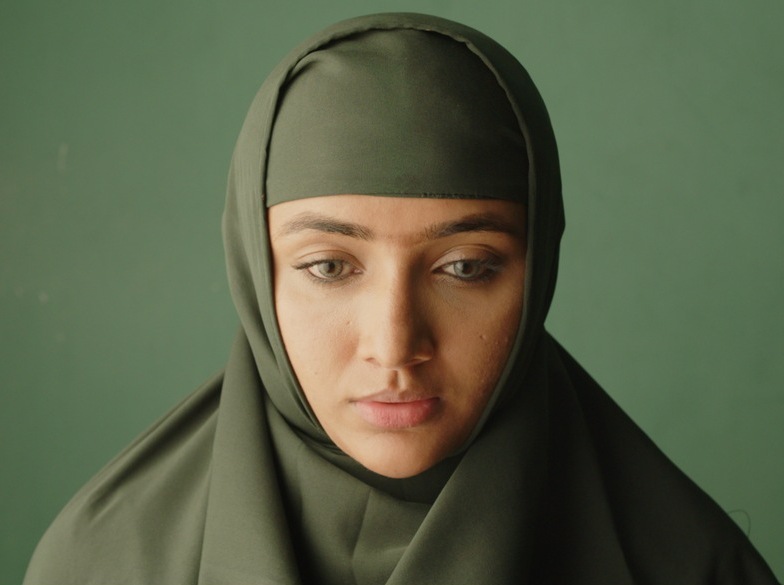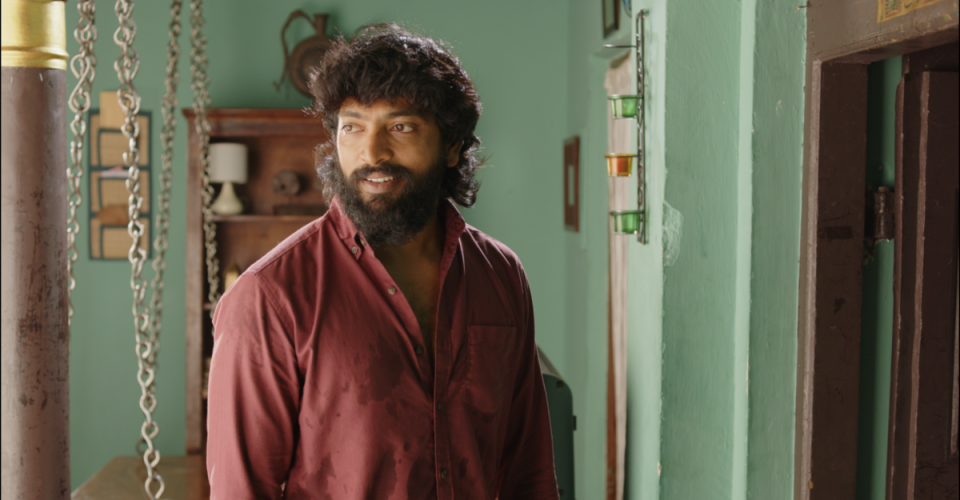
Sarjun KM interview: 'Burqa' sprang from real-life experience, not against purdah

Set against the backdrop of a curfew imposed during a riot in Chennai, Sarjun KM’s Tamil film Burqa, currently streaming on Aha, deals with emotional violence in the name of religion. It challenges the Islamic custom of iddah or iddat under which a widow mourns the death of her husband for four months and ten days, a duration during which she cannot marry another man.
The story revolves around Najma (Mirnaa), an emotionally conflicted widow and a nurse, who finds herself providing shelter to a wounded man named Soorya (Kalaiyarasan), who comes knocking at her door even as the city is in turmoil. Their encounter sets the stage for a debate on religion, gender, and societal norms: the film unfolds through their conversation.
Anusuya Vasudevan’s screenplay lends the film its power, and Balamurugan’s stunning cinematography (he was also the DOP for Blood Money) provides a vivid contrast to its dark and introspective themes. A poignant commentary on gender inequality, religious conflict, and the need for human connection, Burqa raises important questions about tradition, societal expectations, and individual freedom, without resorting to clichés or easy answers.
Also read: Jubilee review: A lavish ode to Hindi cinema, an epic tale of ambition and stardom
In an interview with The Federal, director Sarjun, post-production head of Mani Ratnam’s Ponniyin Selvan (both the parts), said that many people who have not yet watched the film have erroneously presumed it to be critical of the burqa worn by Muslim women.
Sarjun underlined that the film, which struggled for two years for release till it premiered at the 2022 edition of the New York Indian Film Festival, does not pertain to the notion of purdah; instead, it employs burqa as a metaphor to address social issues behind the veil, hidden from plain sight. Excerpts from the interview:
Burqa is a film about the conflict between religion and personal freedom, with the larger message being that humanity is more important than religious belief. How did you arrive at the story?
I did not plan to make a film on this sensitive topic as I was aware of the potential backlash if it was not handled carefully. The inspiration for the story came from a personal experience involving someone close to me, which deeply affected me. I knew then that I had to tell this story at some point, and I began writing it. Finding a producer who shared my passion for the subject was not easy, given its controversial nature. Thankfully, I eventually found someone who believed in the project, and we made it into a film.

As a filmmaker, I do not limit myself to one specific genre or theme. I am always seeking to tell stories that are diverse and engaging, whether it involves social messages, religious themes, or violence. My goal is to explore different genres and to challenge myself creatively with each project. I don’t necessarily plan my themes or stories, but rather, they tend to emerge organically from my experiences and observations.
Also read: Vijay-Lokesh’s Leo: Can it end up as Tamil cinema’s biggest blockbuster?
I am uncertain if I will tackle similar subjects in the future. If a story touches me deeply and demands to be told, then I will consider it. However, I do not have any specific plans or agenda regarding themes for future films. My primary focus is to tell stories that are meaningful, engaging, and thought-provoking.
The film also touches upon issues like patriarchy and societal norms. How did you navigate these complex and sensitive topics while telling the story?
As a filmmaker, my goal is to spark a conversation and ignite debate. It’s not my intention to provide a definitive solution to the complex issues that I portray on screen, as that is beyond the scope of a filmmaker’s role. However, given the prevalence of these issues in society, I strive to use the power of cinema to bring them to the forefront and encourage people to discuss them openly. Ultimately, it’s up to the audience to decide what they believe is right or wrong, and whether they want to take action to effect change. My role is to present the issue through the lens of storytelling and let the audience engage in the conversation. When I tackle another social theme in my next film, I will once again spin the story around it, initiate discussion, and leave it up to the audience to come to their own conclusions. As a filmmaker, I believe it’s not my job to offer judgement or prescribe solutions, but rather to create a space for reflection and dialogue.
The two main characters, Najma and Soorya, come from different backgrounds and have different perspectives. Can you talk about the process of developing their characters and the dynamic between them?
Both Najma and Soorya embody a part of me. The thoughts and conflicts of both characters stem from my own inner turmoil, as I have no clear resolution for these issues. Thus, the conflict between Najma and Soorya reflects the conflict within myself. I don’t have all the answers, and the characters are essentially two sides of the same coin.
When it came to writing the screenplay, Anusuya and I had several discussions to ensure that both sides of the argument were presented. We wanted to highlight the problem and then delve into both perspectives. Even though I had a basic idea of each character, their personalities and traits developed further as we worked on the story. Ultimately, the conflict between Najma and Soorya was necessary to explore the complex themes and ideas that I wanted to convey.
While Anusuya wrote the screenplay, I had to infuse it with my own vision, experiences, and perspective since I had been closely associated with the issue in the past. I had a clear idea of how the dialogues had to be written in a way that would not hurt anyone’s sentiments. It was important for me to ensure that the film didn’t belittle any religion. There are many things in every religion — be it Islam, Hinduism, or Christianity — but, in the end, it boils down to how we interpret them. While writing the dialogues, I had to keep all of these factors in mind, particularly since this is a conversation-heavy film.
A conversation cannot sound like dialogue; it needs to flow naturally and seamlessly, and it has to keep connecting. Since the two characters are shown inside the house for over one and a half hours, my plan was to begin in the hall and progress to the dining area, the kitchen, the lounge, and eventually the bedroom. I had to ensure that every location was linked to the next and led to a point where I had something significant to contribute to the conversation.
The film has a very intimate setting; it takes place mainly in Najma’s home. Did you want the chemistry between the two characters to oscillate between platonic and romantic spectrums, while also maintaining a constant physical tension?
In the end, it is a film, and a film needs conflict to keep the audience engaged. It needs a hook so that you watch it. When that goes out of your hand, it’s not the same thing. With two opposite characters, building conversation was easy. When strangers meet and have to spend a day together, they’ll possibly talk about everything under the sun. Especially, when the girl is in a particular situation. Ultimately, they are all human beings. With a guy and a girl alone in the house, it need not lead to anything physical, but at the same time, it need not be completely disconnected. A basic attraction between a girl and a guy had to be there. We had to bring in a touch of romance; otherwise, it would look like a documentary. But it had to be just enough to create tension. If I went deeper into it, the whole point of what I wanted to say would be diluted.

The film boasts some beautiful and striking cinematography. How did you work with Bala to create the visual style of the film?
I had shared with Bala that the film’s film’s subject could potentially come across as dry to viewers. Given that the conversation was focused on a specific issue, and that most of the film’s events took place inside a single house, there was a risk of people losing interest and moving on to something else. Our only tool was the story itself, and we needed to make it as engaging as possible. To achieve this, we aimed to make every frame of the film look like a painting, despite our limited budget of less than Rs 1 crore.
Also read: A rarity in Tamil cinema: Two anthologies, both focusing on women
We decided that the visual style of the film needed to be striking enough to capture the viewer’s attention. Every frame had to be visually pleasing, like a painting. We were working with a small budget of less than Rs 1 crore, and the decision to focus on the visuals was deliberate. The visual style was a conscious decision we made, with the intention of creating a visually stunning film that would draw in audiences.
Many recent films have explored the oppression and subjugation of women. How do you think Burqa fits into this broader conversation in Indian cinema?
As the story is personal to me, it naturally took a certain shape that had to be told from a woman’s perspective. However, my intention was not to make a film specifically about women or their oppression. Rather, I wanted to explore a particular custom or situation that happened to involve a woman. The film was born out of a personal connection to the subject matter. Perhaps the director of The Great Indian Kitchen, too, had a personal connection with the film. There was no agenda of making the film considering women and their oppression. It was simply the story and its unique situation that demanded to be told in this way.
You have worked with prominent filmmakers like Mani Ratnam and A.R. Murugadoss. Has your experience of working with them influenced your own directorial style?
When you work with a director, I don’t think you can adopt their style or way of storytelling. Your style comes from who you are as a person. From Mani sir, my mentor, and Murugadoss sir, with whom I worked on Kaththi (2014), I learned about execution, which is a challenging skill. I learnt how to bring together the elements to create a blockbuster. I learnt how to manage big actors and still deliver a successful film. From both directors, I took what I wanted, but their style of filmmaking cannot be replicated. Even if you want to replicate it, you will fail, if it is not within you. If it’s within you, then it’s easy to sync up with the director and make a similar film. However, if you are a different person, it’s okay to work with a completely different director because it helps you grow in all other areas, except style because it’s something personal; it has to be yours. You need to have a signature of your own.


